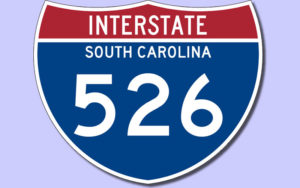By Fred Palm, contributing editor | The S.C. State Infrastructure Bank (SIB) last week voted no (4-3) again on continuing the contract for completing the I-526 extension (I-526X) in Charleston County. On Friday, the county threatened a lawsuit, claiming the SIB couldn’t pull out of the project that would connect West Ashley to Johns Island and end on James Island, traversing the Stono River over the adjacent swamp-wetlands.
 While the final costs of this addition have not been nailed down, it would be the most expensive highway expansion ever built in South Carolina. This is a big deal.
While the final costs of this addition have not been nailed down, it would be the most expensive highway expansion ever built in South Carolina. This is a big deal.
A little history
In 2016, the SIB voted no on the extension project and reiterated a position that said approval was not possible without additional funds. Further, the SIB said it would not allow the project to be partially constructed because it would “reduce the public benefits which were part of the original decision.” The SIB reserved the balance of the $420 million in financial assistance, again requesting Charleston County to come up with a plan to fund the difference.
Back in 2005, the SIB approved all of the funding for the highway extension, then estimated then at $420 million and basically said, “That is it” in terms of state money for the project. Charleston County Council voted 5-3 in 2017 to approve an ordinance committing the county to covering the shortfall for the highway, but it doesn’t specifically the county’s commitment or the source of funding.
Charleston Mayor John Tecklenburg likes this highway but has a $2 billion flood control program to finance. Basically, the SIB was saying to the Charleston County Council, “Show us the money.” Once approved, the SIB essentially said it would put forward the outlines of the financing commitment of the county and the state would go to the bond market that will evaluate the risk and establish the interest rate. But that seems to have ended with last week’s vote, which likely will face a court challenge – continuing the pouring of salt into a huge public policy wound.
Bottom line: Think of the I-526X financing as a dance of musical chairs renamed, “Who owes the money?” There is but one clear answer: Charleston County taxpayers. Even though we do not know what this proposed Interstate highway will cost the county, the majority on the Charleston County Council are willing to saddle us, the current taxpayers, and our children, with the tax burden yet to be determined.
Let’s make a deal
 We do not know what the total costs for the I-526X project so the cost to the Charleston County taxpayers is unknown precisely. Assuming the state does come up with $420 million eventually, there are several things that we do not know that will inflate the cost, perhaps to $1 billion:
We do not know what the total costs for the I-526X project so the cost to the Charleston County taxpayers is unknown precisely. Assuming the state does come up with $420 million eventually, there are several things that we do not know that will inflate the cost, perhaps to $1 billion:
- There is no updated cost estimate subject to inflation.
- Engineering drawings have not been developed so there is no precise estimate reflecting prevailing market prices for tariffs, material, labor and return on investment to get a fix on the real cost offered by real contractors; not politicians seeking to sell the deal with low-ball estimates.
- Field and geological conditions are a wild card as we are building in a swamp.
- Recent research indicates Charleston County will lose quite a few units of existing housing to flooding and the associated tax base; that will likely cause further tax increases or refinancing and stretching the debt further out in time — say 40 or 50 years.
- Add in the additional cost for more high-water flooding that is now conveniently ignored by the county.
- Estimating the interest rate for 30-year bonds in this political environment is another wild card, as this is new territory for lenders financing flood-prone coastal projects over the long-term. The current generic municipal rate is 3 percent.
We need a plan before funding
Take the likely $1 billion total cost of the project, with less than half provided by the state, and all the now unknown overruns paid for by the county taxpayers. Then divide the county cost by the number of present and projected residents. (Growth, however, might stall when new residents take into account sky-high taxes for the highway paying for traffic that will remain congested.) The chart below estimates the local burden per person and per household:
Charleston County’s Capital Plan for FY18-FY21 averages $98 for every man, woman and child now in the county — or $189 per household. If the county’s share of the I-526X cost ended up at $600 million, that would add $76 per person, or $185 per household. If the population grew to the projected 2030 number the annual cost per person the 30-year tax tab would go down to $60 extra per person to use a road that won’t even be accessed by a lot of residents.
The promise to repay the lenders without a realistic assessment reveals a long and costly payout by the taxpayers. The irrefutable flaw is what is being spewed by the county is there is no real financial plan to repay the lenders, and as if it were fully and professionally revealed, it will scare all. This basic flaw, has been repeatedly recognized by the SIB, which is acting, intentionally or not, in the interests of the taxpayers here, even though the current majority of our county local officials are not.
The inescapable conclusion is we have far too few taxpayers, with or without population growth, to shoulder the risks of expanding I-526. If the I-526X repayment burden is added to the tax bill along with the to-be-added flood protections, more school buildings and more connecting roads to serve the rest of the county residents stuck in traffic, our taxes will skyrocket while the region’s basic traffic impasses will not be substantially reduced.
There are far less expensive ways to build a highway to evacuate James and Johns Islands. That is what we should be talking about — the low- cost options of getting that job done. The answer is not this Interstate. We need to move on quickly for the overall public interest.
Fred Palm of Edisto Island is a retired professor of oversight and investigations at the John Jay College School of Public Management and a former executive director of the Association of Inspectors General. He writes about the Common Good.
- Have a comment? Send to: feedback@statehousereport.com.





 We Can Do Better, South Carolina!
We Can Do Better, South Carolina!
























